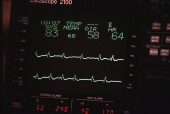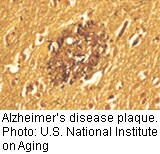| 
Fish Oils May Prevent and Treat Heart Disease
 WEDNESDAY, Aug. 5 (HealthDay News) -- A new review shows that the omega-3 fatty acids found in certain fish not only prevent cardiovascular disease, but may even help treat it.
"A lot of people know that omega-3 fatty acids are a good thing, but have thought of them in the area of nutritional or health foods," said study author Dr. Carl J. Lavie, medical director of cardiac rehabilitation and prevention at the Ochsner Clinic in New Orleans. "They don't realize there is so much data, a lot of data from big studies, that they are not only preventive but also help in therapy for a number of conditions, such as atrial fibrillation, heart attack, atherosclerosis and heart failure."
The report in the Aug. 11 issue of the Journal of the American College of Cardiology cites four trials with almost 40,000 participants that show benefits of omega-3 fatty acids in primary prevention of cardiovascular disease, in treatment after heart attack and, most recently, in heart failure patients.
The benefits of omega-3 fatty acids are such an old story that such studies can go unnoticed, Lavie said. "If you polled cardiologists about whether this is a good thing or a bad thing, I don't know if they would recognize how much has been done in this area," he noted.
As far back as 2002, the American Heart Association issued a scientific statement endorsing omega-3 fatty acid intake, from fish or supplements. It recommended specific amounts of omega-3 fatty acids each day for people in general, with greater intake recommended for people with heart disease.
"For the general population, it should be 500 milligrams a day," Lavie said. "If you have heart disease, it should be 800 or 1,000 milligrams a day."
Lavie includes himself in the second category, because "I have a family history of heart disease. I eat a lot of fish and take a supplement just to be sure."
It's got to be the right kind of fish, the oily species that have a lot of omega-3 fatty acids, Lavie added. "Redfish, trout, salmon," he said. "Salmon is my favorite."
Not much effort is needed for most people to achieve the recommended intake, Lavie said. "Five hundred milligrams a day is two fatty fish meals per week," he added.
But too many people eat non-oily fish such as catfish, Lavie noted. "And they have it fried, which reduces its health benefits," he added.
His review did turn up a few negative studies, including one showing no benefits of omega-3 fatty acids in people who had heart attacks. But it was a relatively small (4,000 people), short (one-year) trial, and the patients in the trial were already getting intensive drug therapy including clot-busting clopidogrel, cholesterol-lowering statins, beta blockers and ACE inhibitors, Lavie noted.
Set against that one trial are the many larger studies cited by Lavie, and epidemiological evidence showing that populations such as Asians and Alaskan Eskimos, whose diets are rich in fish oil, have a low incidence of cardiovascular disease.
The picture is not complete, the new report noted. Studies still must be done to determine the relative benefits of DHA and EPA, the long-chain fatty acids in the omega-3 family. And the American Heart Association says that Omega-3 supplements should be taken only after consulting with a doctor, because too much can cause excessive bleeding in some people.
Another study now in the recruiting stage will test omega-3 fatty acids to prevent not only cardiovascular disease but also cancer, said Dr. JoAnn Manson, chief of preventive medicine at the Harvard-affiliated Brigham and Women's Hospital.
She is a leader of the trial, which is now recruiting 10,000 men aged 60 and older and 10,000 women aged 65 and older. The researchers will test not only the effect of omega-3 fatty acids but also of vitamin D.
Both are "very promising nutrients in prevention of cardiovascular disease, cancer and other chronic diseases," Manson said. In the five-year trial, a quarter of the participants will take both vitamin D and omega-3 fatty acids, a quarter will take the vitamin, a quarter will take the fatty acids and a quarter will take a placebo.
Enthusiasts shouldn't anticipate the results of the trial and start taking large doses of omega-3 fatty acids, Manson warned. "It's too early to jump on the bandwagon and take megadoses, but moderate doses seem reasonable," she said.
More information
Get the official view of the value of omega-3 fatty acids from the American Heart Association  . .
|  |

Less Aggressive Care for More Severe Heart Disease
 WEDNESDAY, Aug. 5 (HealthDay News) -- A study assessing the treatment of people hospitalized for heart disease has produced a worrisome finding: Those who need intensive care the most are less likely to get it.
The study of 143,999 people hospitalized between 2000 and 2008 found that those with previously diagnosed atherosclerosis -- hardening of the arteries -- were less likely to undergo artery-opening surgery and get cholesterol-lowering drug therapy than those with no such diagnosis. They also had longer hospital stays and were more likely to die in the hospital.
"We knew that patients with prior disease have worse outcomes, higher mortality and stay in the hospital longer. But we would expect these patients to be getting better therapy," said Dr. Emmanouil S. Brilakis, director of cardiac catheterization laboratories at Veterans Administration North Texas Healthcare System and lead author of a report released in the Aug. 4 issue of Circulation.. "The surprise is that they get less of the therapies recommended in guidelines compared to those who have no prior diagnosis."
The researchers used data from the American Heart Association's "Get With the Guidelines -- Coronary Artery Disease" program. They did find higher compliance with some of the guidelines for those with previous atherosclerosis. For example, 92 percent were given aspirin and a beta blocker drug more than 95 percent of the time, consistent with what was prescribed for all patients.
But while 90 percent of those who had no previous diagnosis of blocked arteries were given counseling on smoking cessation, that counseling was given to 88 percent of those with one blockage, 85 percent of those with two blockages and 79 percent of those with three blockages.
Similarly, cholesterol-lowering drugs were prescribed for 89 percent of those with no previous blockages and just 77 percent of those with three blocked arteries.
Why is this happening?
"We can only make hypotheses," Brilakis said. "Maybe some of these patients are so sick that physicians decide that being aggressive with them would not be the best course of action. Or they have been told many times to do something, and maybe physicians just give up on them."
Or maybe it's a question of money, he added. The incidence of atherosclerosis is highest among people without a lot of money, he said, "and they may not have the same health insurance coverage that other people do."
One problem is that when people think of heart disease, they think only of the heart, said Dr. Adrian F. Hernandez, an assistant professor of medicine at Duke University, and a member of the research team.
"Most people just focus on coronary disease," Hernandez said. "People may not realize the risk that is involved with multiple areas of vascular [blood vessel] disease."
"We need more education in terms of the principles of care for high-risk patients," Hernandez said. "The hope is that by highlighting this issue, we will have greater adherence to the guidelines of care."
The next step is a planned study to pinpoint the reasons for differences in care, Brilakis said. That study will question both physicians and people hospitalized for heart disease about all the factors that can affect treatment decisions, he said.
"We want to get more specific," Brilakis said. "Are patients saying they don't want aggressive treatment? Do they not have enough insurance? Why are physicians reluctant to give aggressive treatment?"
More information
Details of the "Get With the Guidelines" program are described by the American Heart Association  . .
|  |

Midlife Heart Risk Factors Linked to Later Dementia
 TUESDAY, Aug. 4 (HealthDay News) -- The things that are bad for your heart in the middle years of life -- high blood cholesterol, high blood pressure, smoking, diabetes -- are bad for your brain in later years, new research indicates.
High cholesterol levels in midlife were associated with an increased risk of Alzheimer's disease and other forms of dementia many years later, according to scientists in California and Finland, who tracked almost 10,000 men and women for four decades.
"We found an association not only with high blood cholesterol, but also borderline high levels," said study senior author Rachel Whitmer, who is a research scientist and epidemiologist at the Kaiser Permanente division of research in Oakland. Researchers at the University of Kuopio in Finland also participated in the study.
Total cholesterol levels of 240 milligrams per deciliter or higher in middle age were associated with a 66 percent higher incidence of Alzheimer's disease decades later, the researchers found.
"But that wasn't a cutoff point," Whitmer said. "Around a level of 200, the risk of Alzheimer's disease started to go up."
For those in midlife with borderline-high readings between 200 mg/dl and 239 mg/dl, the increased incidence was 52 percent, according to the study, which was published online in the journal Dementia and Geriatric Cognitive Disorders and funded by the U.S. National Institutes of Health.
The Californians in the study were more ethnically diverse than the Finnish participants, and included blacks, Latinos and Asians, but "the association between high cholesterol and dementia was the same across all ethnic groups," Whitmer noted.
The other research, reported in the August issue of the Journal of Neurology, Neurosurgery and Psychiatry, followed more than 11,000 American participants in a study of atherosclerosis, the hardening of the arteries that can lead to heart attack, stroke and other major cardiovascular problems.
Researchers from the University of Minnesota, the University of North Carolina, John Hopkins and the University of Mississippi Medical Center measured smoking, high blood pressure and diabetes among the participants from 1990-1992. They then tracked them until 2004 to see how many were hospitalized for dementia.
Smokers were 70 percent more likely to develop dementia than nonsmokers; those with high blood pressure were 60 percent more likely, and those with diabetes were twice as likely as those without diabetes to develop dementia. However, there was no link between midlife obesity and later dementia.
The idea behind the study was that "if we find risk factors for dementia, maybe we can develop new treatments, preventive programs to reduce the risk of dementia later in life," said study author Dr. Alvaro Alonso, an assistant professor of epidemiology at the University of Minnesota's School of Public Health.
Post-mortem studies of brains of people who had dementia often show damage to small arteries, he said. "Maybe there have been small strokes, which are not great enough to cause clinical symptoms, but in time can lead to dementia," Alonso said.
Measures against dementia now usually start when its first signs are detected, Alonso said. "Showing that cardiovascular risk factors earlier in life have an impact on dementia later in life gives another reason why we need to intervene with those cardiovascular risk factors," he said.
The findings of both studies "are an extension of what already has been found," said Michelle Mielke, an assistant professor of psychiatry at Johns Hopkins University, who has done research on the causes of dementia.
"Both papers really point out the need to intervene in vascular factors in midlife," Mielke said. "They are as important in the risk of dementia as they are in the risk of heart disease and stroke."
No new approach is needed, she said, just a renewed emphasis on "exercise, diet, that kind of stuff."
More information
Risk factors for dementia are described by the U.S. National Institute of Neurological Disorders and Stroke.
|  |

Vitamin D Deficiency Linked to Heart Risk Factors in Kids

MONDAY, Aug. 3 (HealthDay News) -- Most American youngsters aren't getting enough vitamin D, and that deficiency is associated with an increased incidence of risk factors for cardiovascular problems such as heart attack and stroke, two new studies find.
Simultaneous publication of both papers in the Aug. 3 online edition of Pediatrics is coincidental, the lead authors of the reports said. Both used U.S. data from the 2001-2004 National Health and Nutrition Examination Survey, and both were initiated because of a lack of information about the possible effects of low vitamin D levels on cardiovascular risk in young people.
While studies have linked vitamin D deficiency to increased risk in American adults, "few studies have looked at whether vitamin D can be associated with increased cardiovascular disease in children," said Jared P. Reis, who began his study while at Johns Hopkins University. He is now an epidemiologist in the division of cardiovascular sciences of the U.S. National Heart, Lung, and Blood Institute.
"Nobody questions that vitamin D deficiency causes rickets," said Dr. Michal L. Melamed, an assistant professor of medicine and epidemiology at Albert Einstein College of Medicine in the Bronx, who led the other study. "We wanted to explore other health outcomes and noticed that nobody had described this outcome."
The study she led looked at the overall incidence of low blood levels of vitamin D among young Americans aged 1 to 21 in the survey. There is no formal definition of vitamin D deficiency, Reis said, but many experts believe that a level of 30 nanograms per milliliter of blood is desirable.
The Melamed study found that 9 percent of young Americans -- 7.6 million -- were vitamin D-deficient, with blood levels under 15 nanograms per milliliter, and that 61 percent -- 50.8 million -- were vitamin D-insufficient, with levels between 15 nanograms and 29 nanograms per milliliter.
The high incidence of vitamin D deficiency was so surprising that "we sat on our data for six months," Melamed said. "We didn't publish until it was confirmed by other people that we had the right numbers."
Children with the lowest vitamin D levels were more likely to have higher blood pressure, high blood sugar levels and low blood levels of HDL ("good") cholesterol, the study found.
It's not entirely certain that low levels of vitamin D early in life will translate into health problems in the adult years, Melamed said. "But if you have hypertension [high blood pressure] at age 20, you have 60 more years of dealing with the consequences," she noted.
The study led by Reis was a detailed cross-sectional analysis of data on 3,577 adolescents. It found an average vitamin D blood level of 24.8 nanograms per milliliter. The average level was 15.5 nanograms per milliliter in blacks, 21.5 in Mexican Americans and 28 in whites.
There was a clear association with cardiovascular risk factors. The 25 percent of youngsters with the lowest levels of vitamin D were 2.36 times more likely to have high blood pressure, 54 percent more likely to have low HDL cholesterol levels, 2.54 times more likely to have elevated blood sugar levels and 3.88 times more likely to have metabolic syndrome, a constellation of risk factors including obesity, high blood fats and high blood pressure.
But the results should not panic parents, Reis said. "I believe we need additional research," he said. "Our study is observational, and we need additional studies to confirm it."
Specifically, parents need not turn to supplements to provide the recommended intake of vitamin D, currently set at 200 International Units a day for everyone up to age 50, Reis said. Adequate vitamin D intake can be achieved with 15 minutes a day of exposure to sunlight or consuming fortified milk, bread and other wheat products, among other foods, he said.
"Parents should focus on modifiable risk factors," Melamed said. "Children should not always be on the computer or watching television. They can drink more milk, rather than using supplements."
More information
Sources and effects of vitamin D are described by the U.S. National Library of Medicine.
|  |
|